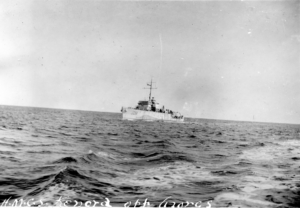Official History of

HMCS KENORA, the first of the six Bangor Class minesweepers built by the Port Arthur Shipbuilding Company, Ltd, was commissioned on 6 August 1942. Her specifications, as those of all Canadian steam Bangors, were:
Length overall180’
Breadth, extreme28’ 6”
Draught, full load, aft11’ 9”
Speed, maximum16½ knots
Displacement, standard672 tons
Endurance, cruising2,950 miles.
Her twin screws were driven by two triple-expansion, steam reciprocating engines of 2,400 horse-power. She mounted a single 12-pounder gun, one twin Oerlikon, and two single Oerlikons. As purely anti-submarine armament she carried from forty to seventy depth-charges.
Though technically a minesweeper, KENORA’s task during her first seventeen months of active duty was convoy escort work. Based at Halifax, and later at St. John’s, Newfoundland, she escorted thousands of merchant ships safely through the dangerous waters of the Canadian east coast to their destinations. Often her convoys were small local ones, such as those between Wabana and Sydney; many were larger and more important, such as those between Halifax and Boston. Occasionally she joined local escort forces to help escort the vital transatlantic convoys to and from the Western Ocean Meeting Point, a position to the eastward of Newfoundland.
Early in 1944 an urgent request from the Admiralty for Canadian Bangor minesweepers to take part in the Normandy landings brought KENORA to the United Kingdom. She arrived in Plymouth on 8 March 1944, and was allotted to the 14th (British) Minesweeping Flotilla.
During the landings in Normandy, KENORA, like the other Canadian Bangors, was in the van of the invasion fleet, sweeping a path for the assault craft under virtually point-blank fire from the enemy shore batteries. For five months, from June to October, she was in constant service, performing with distinction her difficult and vital task.
On 19 November 1944, KENORA returned to Halifax for refit, but by 2 April 1945, she was back in Plymouth again. Within two weeks she was in the thick of the battle again, sweeping with the 31st Canadian Minesweeping Flotilla in the Gironde operations designed to open the port of Bordeaux to allied ships. The end of the war in Europe did not bring any respite for the minesweepers, and KENORA worked on until the end of August. On 4 September she left England for home.
Upon her return to Canada, KENORA was paid off, and turned over to the War Assets Corporation for disposal. She was eventually sold to Marine Industries, Limited, and remained in their anchorage at Sorel, P.Q., in “strategic reserve” until reclaimed by the RCN in 1951. After undergoing a thorough modernization and refit programme, she was allotted to reserve and taken to her present station, the Point Edward Naval Base at Sydney, N.S.


 CFB Esquimalt Naval and Military Museum
CFB Esquimalt Naval and Military Museum
 CFB Esquimalt Naval and Military Museum
CFB Esquimalt Naval and Military Museum CFB Esquimalt Naval and Military Museum
CFB Esquimalt Naval and Military Museum CFB Esquimalt Naval and Military Museum
CFB Esquimalt Naval and Military Museum CFB Esquimalt Naval and Military Museum
CFB Esquimalt Naval and Military Museum CFB Esquimalt Naval and Military Museum
CFB Esquimalt Naval and Military Museum CFB Esquimalt Naval and Military Museum
CFB Esquimalt Naval and Military Museum CFB Esquimalt Naval and Military Museum
CFB Esquimalt Naval and Military Museum CFB Esquimalt Naval and Military Museum
CFB Esquimalt Naval and Military Museum CFB Esquimalt Naval and Military Museum
CFB Esquimalt Naval and Military Museum CFB Esquimalt Naval and Military Museum
CFB Esquimalt Naval and Military Museum CFB Esquimalt Naval and Military Museum
CFB Esquimalt Naval and Military Museum
 CFB Esquimalt Naval and Military Museum
CFB Esquimalt Naval and Military Museum CFB Esquimalt Naval and Military Museum
CFB Esquimalt Naval and Military Museum CFB Esquimalt Naval and Military Museum
CFB Esquimalt Naval and Military Museum CFB Esquimalt Naval and Military Museum
CFB Esquimalt Naval and Military Museum CFB Esquimalt Naval and Military Museum
CFB Esquimalt Naval and Military Museum CFB Esquimalt Naval and Military Museum
CFB Esquimalt Naval and Military Museum CFB Esquimalt Naval and Military Museum
CFB Esquimalt Naval and Military Museum CFB Esquimalt Naval and Military Museum
CFB Esquimalt Naval and Military Museum CFB Esquimalt Naval and Military Museum
CFB Esquimalt Naval and Military Museum CFB Esquimalt Naval and Military Museum
CFB Esquimalt Naval and Military Museum

 CFB Esquimalt Naval and Military Museum
CFB Esquimalt Naval and Military Museum CFB Esquimalt Naval and Military Museum
CFB Esquimalt Naval and Military Museum CFB Esquimalt Naval and Military Museum
CFB Esquimalt Naval and Military Museum CFB Esquimalt Naval and Military Museum
CFB Esquimalt Naval and Military Museum CFB Esquimalt Naval and Military Museum
CFB Esquimalt Naval and Military Museum
 CFB Esquimalt Naval and Military Museum
CFB Esquimalt Naval and Military Museum



 CFB Esquimalt Naval and Military Museum
CFB Esquimalt Naval and Military Museum



































 CFB Esquimalt Naval and Military Museum
CFB Esquimalt Naval and Military Museum CFB Esquimalt Naval and Military Museum
CFB Esquimalt Naval and Military Museum
 CFB Esquimalt Naval and Military Museum
CFB Esquimalt Naval and Military Museum